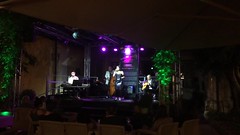
- Image by Getty Images via Daylife
We’re now well into our second year with the STEMmED project, and it’s time to make some personal and project-wide evaluations. So, I’d like to talk a bit about STEMmED and what our great team did in the first year; what are our beliefs and our plans, both short- and long-term.
STEMmED is about bringing more students to the Sciences. As simple as that. The US Department of Education (together with other branches of gov) has deemed that there are not enough scientists, mathematicians, technologists and engineers to sustain growth and progress. Among Hispanics, the numbers are even worse. Thus, we are working to establish an infrastructure 1) to help students understand and learn science effectively; and 2) to bring more students to the STEM fields, by working, among other methods, with the often incorrect perception of science they have absorbed from society.
Barack Obama said recently:
We are going to show young people how much fun it is to study science.
This is what we’re doing.
1. Infrastructure: remodeling labs, both traditional biology, chemistry and biotech labs and the new Science Media Lab with the annexed Science Café. The SML is beloved by students, since its opening in April 2009 it has always stayed full at capacity. Students love to work, chat, collaborate there with other students and with our programmers staff. The Science Café is a state-of-the-art videoconferencing facility open all day long to view science-related videos and conferences. Part of the infrastructure is the implementation of STEMmED’s Web portal: http://stemmed.sagrado.edu.
2. The Syndication Bus. Jim Groom has been the inspiration for our implementation of his Syndication Bus architecture. With WordPress MU and a few plugins, we are setting up a multiuser blogging platform through which everybody in the campus may publish content. His/her own content, plus course-specific stuff. Thus, a student may set up her own blog and publish whatever she deems fit (that blog would also include her personal portfolio, which she’d bring with herself after college). When she needs to publish something on the course blog-site she only has to write it **on her own blog** but with a specific course tag. Voilá the Syndication Bus in action. This beautiful architecture is extensible beyond the sciences and may reach all the university.
3. It would be useless to have a Lab and publishing platform if it weren’t integrated into faculty’s work and teaching strategies. This is why we got our sciences faculty into a week-long intensive training on Web 2.0 technologies and pedagogies, including Blogging and specific Instructional Design. Science courses also were redesigned along the lines of Web 2.0 openness and publication schemes.
4. Pipeline from High School. We opened our doors to 15 freshmen for a 3-week inmersion in Science, Maths, and language which included site visits, workshops, conferences and lab experiences. These 15 students are happily working their first year now in their science major. We’re getting ready to host 25 freshmen this year, June 1-18.
5. Last, Research, through faculty members who chose to pursue research project with our sponsorship. All research activity included two or three students per researcher, thus providing students with great opportunities to better understand the experimental nature of science.
WOW! That’s a lot of work! And it has been possible only thanks to our great team: Doribel Rodríguez (Computing), Mayra Alonso (Mathematics), María Lázaro (Biology) and John Olmo (Chemistry). Héctor del Manzano is the sofware architect and deus ex machina, and is responsible of the WPmu installation. Plus, we have many students from Computing and other areas who serve as programmers, tutors, or TA’s. I want to thank ALL OF THIS PEOPLE who so enthusiastically are working their best for this project.
 Now, I’ll deal a little with the pedagogical model we’re following, and the discussion it has brought about between the LMS worldview and the WP-only vision which so many people advocate. We have compromised with a middle solution and ended up using both Moodle as our leading LMS solution for the didactic scaffolding it provides, and the Syndication Bus architecture centered around WP. This model also uses social bookmarking as an asynchronous communication scheme to share resources and ideas, plus a few other Web 2.0 tools. We have also built an island in Second Life to provide students and faculty a virtual world where both can enhance their class experiences and meet and discuss together their assignments.
Now, I’ll deal a little with the pedagogical model we’re following, and the discussion it has brought about between the LMS worldview and the WP-only vision which so many people advocate. We have compromised with a middle solution and ended up using both Moodle as our leading LMS solution for the didactic scaffolding it provides, and the Syndication Bus architecture centered around WP. This model also uses social bookmarking as an asynchronous communication scheme to share resources and ideas, plus a few other Web 2.0 tools. We have also built an island in Second Life to provide students and faculty a virtual world where both can enhance their class experiences and meet and discuss together their assignments.
Supporting material comes from Dr. Rosa Ojeda’s course redesign blog, which provides (in Spanish) the practical foundation for faculty redesign and teaching work: http://estrategiasstemmed.wordpress.com/
Last, I cannot forget the tremendous impact we have had from the participation of such personalities as Mike Wesch, Jim Groom, Mario Núñez and José Sánchez in our project. Mike delivered a wonderful keynote for our Symposium on Science & Web 2.0 (May 15, 2009), which was followed by astronomer Daniel Altschuler‘s talk and a productive discussion panel. The Puerto Rican Science and Education community participated en masse!
Jim and Mario offered us their long term collaboration and a few workshops which were absolutely well received among the participating faculty. José Sánchez is our lead in Second Life and has helped us with his pedagogical insights and workshops. Together with him also Rossana Barrios and José Luís Quiñones worked very hard to build our STEMmED island. Thanks to all!!!

![Reblog this post [with Zemanta]](http://img.zemanta.com/reblog_e.png?x-id=72d72ddf-252f-4692-abbc-b70641d7043c)


